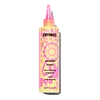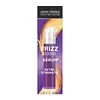What's inside
What's inside
 Key Ingredients
Key Ingredients

No key ingredients
 Benefits
Benefits

No benefits
 Concerns
Concerns

 Ingredients Side-by-side
Ingredients Side-by-side

Water
Skin ConditioningGlycerin
HumectantPropylene Glycol
HumectantGlycolic Acid
BufferingLactic Acid
BufferingHippophae Rhamnoides Fruit/Seed Oil
AntimicrobialCocos Nucifera Oil
MaskingNymphaea Alba Root Extract
Skin ConditioningAloe Barbadensis Leaf Juice
Skin ConditioningPanthenol
Skin ConditioningTrehalose
HumectantEthyl Linoleate
EmollientEthyl Oleate
EmollientPolyglyceryl-10 Laurate
Skin ConditioningDipropylene Glycol
HumectantCaprylic Acid
CleansingXylitol
HumectantMaltodextrin
AbsorbentTocopherol
AntioxidantCetearyl Alcohol
EmollientBehentrimonium Chloride
PreservativeCetrimonium Chloride
AntimicrobialSilicone Quaternium-8
Trideceth-10
CleansingPhenyl Trimethicone
Skin ConditioningEthylhexylglycerin
Skin ConditioningPolyquaternium-10
Polyquaternium-7
Sorbitol
HumectantSodium Lignosulfonate
Ceresin
Emulsion StabilisingHydroxyethylcellulose
Emulsion StabilisingMagnesium Aluminum Silicate
AbsorbentDisodium Phosphate
BufferingSodium Phosphate
BufferingBenzyl Alcohol
PerfumingCitric Acid
BufferingPhenoxyethanol
PreservativeParfum
MaskingBenzyl Benzoate
AntimicrobialHydroxycitronellal
PerfumingLimonene
PerfumingWater, Glycerin, Propylene Glycol, Glycolic Acid, Lactic Acid, Hippophae Rhamnoides Fruit/Seed Oil, Cocos Nucifera Oil, Nymphaea Alba Root Extract, Aloe Barbadensis Leaf Juice, Panthenol, Trehalose, Ethyl Linoleate, Ethyl Oleate, Polyglyceryl-10 Laurate, Dipropylene Glycol, Caprylic Acid, Xylitol, Maltodextrin, Tocopherol, Cetearyl Alcohol, Behentrimonium Chloride, Cetrimonium Chloride, Silicone Quaternium-8, Trideceth-10, Phenyl Trimethicone, Ethylhexylglycerin, Polyquaternium-10, Polyquaternium-7, Sorbitol, Sodium Lignosulfonate, Ceresin, Hydroxyethylcellulose, Magnesium Aluminum Silicate, Disodium Phosphate, Sodium Phosphate, Benzyl Alcohol, Citric Acid, Phenoxyethanol, Parfum, Benzyl Benzoate, Hydroxycitronellal, Limonene
 Reviews
Reviews

Ingredients Explained
These ingredients are found in both products.
Ingredients higher up in an ingredient list are typically present in a larger amount.
Limonene is a fragrance that adds scent and taste to a formulation.
It's found in the peel oil of citrus fruits and other plants such as lavender and eucalyptus. The scent of limonene is generally described as "sweet citrus".
Limonene acts as an antioxidant, meaning it helps neutralize free radicals.
When exposed to air, oxidized limonene may sensitize the skin. Because of this, limonene is often avoided by people with sensitive skin.
The term 'fragrance' is not regulated in many countries. In many cases, it is up to the brand to define this term. For instance, many brands choose to label themselves as "fragrance-free" because they are not using synthetic fragrances. However, their products may still contain ingredients such as essential oils that are considered a fragrance.
Learn more about LimoneneParfum is a catch-all term for an ingredient or more that is used to give a scent to products.
Also called "fragrance", this ingredient can be a blend of hundreds of chemicals or plant oils. This means every product with "fragrance" or "parfum" in the ingredients list is a different mixture.
For instance, Habanolide is a proprietary trade name for a specific aroma chemical. When used as a fragrance ingredient in cosmetics, most aroma chemicals fall under the broad labeling category of “FRAGRANCE” or “PARFUM” according to EU and US regulations.
The term 'parfum' or 'fragrance' is not regulated in many countries. In many cases, it is up to the brand to define this term.
For instance, many brands choose to label themselves as "fragrance-free" because they are not using synthetic fragrances. However, their products may still contain ingredients such as essential oils that are considered a fragrance by INCI standards.
One example is Calendula flower extract. Calendula is an essential oil that still imparts a scent or 'fragrance'.
Depending on the blend, the ingredients in the mixture can cause allergies and sensitivities on the skin. Some ingredients that are known EU allergens include linalool and citronellol.
Parfum can also be used to mask or cover an unpleasant scent.
The bottom line is: not all fragrances/parfum/ingredients are created equally. If you are worried about fragrances, we recommend taking a closer look at an ingredient. And of course, we always recommend speaking with a professional.
Learn more about Parfum